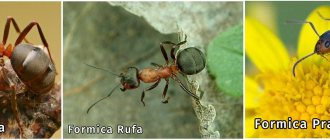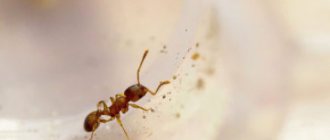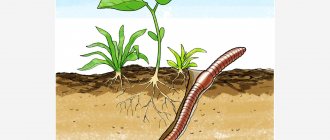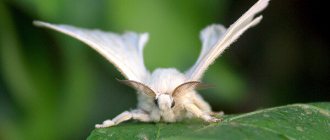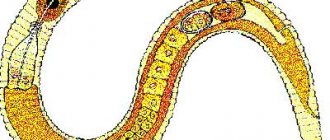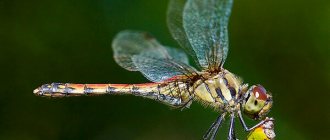Ants
Ant queen
Worker ants
Like a hive, an anthill is a complex social structure. The life of ants in nature is so organized and subject to the demands of the community that it is difficult to believe that insects lack intelligence. But an individual individual most definitely has only instincts. The version of collective intelligence has so far only appeared in science fiction novels. But even in the absence of reasonable actions, the ant community is able to build its own social ladder with its own “elevator”.
What is an anthill from the point of view of social structure
When talking about an anthill, the overwhelming majority of people imagine a mound in the forest or a hole in the ground, near which many small black or red biting insects are hovering. But “home” is not the most important thing in the life of ants. There are representatives who manage without a “base” at all. These are nomadic species that breed during breaks in bivouac nests. Others make their nests in trees to escape the annual tropical downpours. Synanthropic species of ants can organize a nest in the wall of a house or a ventilation hole.
If we consider these insects from the point of view of the community, then an anthill is a colony of organisms with individuals divided into classes according to the actions they perform:
- womb or queen;
- males;
- workers;
- soldiers.
Interesting!
Workers and soldiers are underdeveloped females, incapable of independent reproduction.
Ant farm video
"Better to see once than hear a hundred times". This folk wisdom is also relevant for myrmekeepers, only many of them would paraphrase the saying: “It’s better to see once than to read a hundred times.” Indeed, a visual demonstration of the tricks of keeping ants in a video in Russian is quickly learned and turns out to be very useful. Therefore, the first place a novice ant lover turns to is YouTube , where they simply type in the search phrase “ video about an ant farm .” However, if you delve deeper into the topic, you will find that YouTube is a repository of many videos on ant topics, but not all of them can help you. Entertainment content with controversial experiments, as a rule, has no practical value in our hobby. Such videos are created mainly for children who are interested in watching everything.
How are videos useful? Of course, because you can look at a review of a home ant farm, choose a suitable design for your needs, learn the intricacies of maintenance and simply get acquainted with different types of ants. To make it easier for beginners to navigate the wide variety of materials, we have prepared several useful videos on various topics.
- What is so remarkable about these insects that keeping them has become such a popular hobby? An anthill is a small civilization that is capable of working as a single organism. The population of an ant nest is constantly on the move. Hunting, gathering, competition with other species and protecting territory, exploring new lands, laying roads, building and strengthening homes - these insects never get bored. The fascination with ants was born from observations in nature. Even the ancient Greek philosophers loved to contemplate the life of ants, comparing their society and ours. Before you get ants at home, watch them in nature, this is a very exciting activity!
There are more than 14 thousand species of ants in the world, differing in appearance and behavior. Among them there are giants and dwarfs, inhabitants of deserts and tropical rainforests, hunters and parasites, pests and friends of man. Although there are many ants, houses contain only a small part of the natural diversity. For a person who is not interested in ants, they all look the same, but this is not at all true.
- Planting ants in a jar of soil will not work - they need a decent home, which, although it will differ from the natural one in appearance, material and the ability to observe life in the nest, will be able to correspond to its natural counterpart in all microclimate characteristics, so that your pets feel good there . This is an ant farm, a formicarium. Ant farms can be made of plaster, acrylic, sand, wood, horizontal and vertical, portable and stationary, modular, collapsible - their design is limited only by common sense, imagination and the capabilities of the manufacturer. Reviews on formicariums are what will help you make your choice. And once you have decided, you will understand from these videos how to assemble a farm that is supplied disassembled.
- You should buy ants and a farm only from trusted manufacturers with a reputation that has been proven over the years. Now there are many online stores with low-quality goods and even outright scammers! Choose carefully so as not to get into trouble.
- Once you have purchased a formicarium, it is not necessary to buy ants for it if you are interested in local species. To do this, you need to wait for flight - the time when winged queens and males fly out of anthills. After they form pairs in the air, the males die, and the females break off their wings and look for shelter in which they can establish a new anthill. That's when you need to catch wingless queens.
- A captured queen cannot be immediately placed in a formicarium, because such space will cause stress in an insect that is accustomed to raising children in a small, cramped chamber. To make the uterus feel comfortable, you need an incubator in which the humidity is maintained at a stable level. Test tubes are usually used for the base of the incubator, but if you don’t have them on hand, even a syringe will do.
- Raising a colony from a queen is quite simple, since in most species the queen does not even eat until the workers emerge. The main thing is not to disturb the uterus, not to watch it every minute. It can be put away in the incubator in a closet, thereby providing two main factors: darkness and peace. The most common and easy to raise ants for a home ant farm are Messor structor (steppe harvester ant) and Lasius niger (black garden ant).
- After the workers appear, your pets need to be fed more often. How? It depends on the species. The already mentioned Lasius niger, for example, eat food insects and drink syrup, and Messor structor eats food insects and seeds. The syrup is made from honey or sugar diluted with water. Forage insects are bred at home specifically to feed ants or purchased at a pet store.
- After the ant family has grown up, it can already be moved to the formicarium. This process is not quick, you will have to be patient. But if you want to “push” a particularly leisurely colony a little, there are a couple of methods using what ants don’t like: light and vibrations, for example. Or gently pour the ants into the formicarium arena.
- Ants are infested. What to do next, how to care for them and the farm? How to moisten the formicarium and clean the arena from debris?
- The colony grows and may eventually outgrow the first formicarium. Then you need to move the ants to a larger farm. What to do with the old one? Disassemble and clean! After this, new pets can be placed there.
So, your ants live, reproduce and prosper, and you can already be called a myrmekeeper! Because you now know everything or almost everything about caring for ants and the ant farm.
Ant social classes
Ants
The many different activities performed for the normal functioning of the ant family have led to the emergence of different classes of insects. Each individual strictly performs only its own duties, without trying to interfere in the affairs of a comrade. It is difficult to say whether these class layers can be classified as castes of ants, since in the “traditional” understanding, caste is a rather closed world.
Lifespan of infertile females
When determining the lifespan of the bulk of insects in an ant community, one must take into account not so much calendar time as how ants live in each climate zone. And it’s better to count in months.
The lifespan of a non-hibernating insect in the tropical jungle is 1 year or 12 months. The lifespan of an ant near the polar zone is 3–4 years. But the latter are active only 3 months a year. The remaining 9 months of insects spend the winter in suspended animation, in which the vital activity of their body slows down almost to zero. As a result, the life expectancy of a circumpolar ant is the same 12 months as that of a tropical ant.
How is the inside of an anthill arranged, what is its structure?
Sectional diagram of the structure of an anthill with the designation of functional chambers.
Structure of an ant colony. Most often, dome-shaped anthills are found, but sometimes ants prefer to settle in rotten tree trunks or large old stumps. In regions with extremely hot climates (for example, deserts), insects build their homes exclusively underground.
The inside of an anthill looks different, but the structure of the allocation and organization of specialized chambers is characteristic of any nest of ants.
Indoor cameras can be divided into the following categories:
- “ solarium ” - a small chamber under the very dome of the anthill, insects bask in it in the warm season;
- “ wintering chamber ” - located below the soil level, in which the ants survive the cold, plunging into suspended animation;
- “royal chamber” or “ queen’s room ” - here is the queen who lays eggs;
- “grain barn” or “ granary ” - intended for storing grass and tree seeds;
- “kindergarten” or “ nursery ” - chambers in which eggs mature and ant larvae are born;
- “meat pantry” or “ refrigerator ” - they store the corpses of insects, worms and caterpillars.
- “cow barn” - where ants contain and raise aphids.
- " graveyard " is a place where waste and deceased individuals are found. It is significantly removed from the anthill, since the ants understand that corpses and waste are a source of disease and infection;
Each sexually mature insect has a clear idea of the location of the chambers. An increase in the anthill leads to the expansion of existing chambers and the construction of new premises.
The depth of the anthill underground can reach up to 2 meters and has an organized complex structure. And the above-ground part can be from 30 cm to 2 m high. All this looks like a huge city.
The depth and structure of an ordinary anthill are amazing. The insides of this amazing structure consist of large fragments of branches. Between them there are many galleries leading to individual chambers, which is a rather complex device.
The height of the structure varies from 30 cm to 2 m, the underground part most often exceeds the above-ground area. The outer covering consists of small twigs, pine needles, grains of sand and reliably protects ants from dampness, wind and cold. The structure of the underground anthill of the garden ant is similar to the forest one, but on the surface it is only a small sandy mound.
Here are a few photos of what a large forest anthill looks like:
The underground part, as a rule, is comparable, and often exceeds the above-ground part in size. In places where there are large reserves of resources for ants (water, cereals, insects of other species), dwellings can reach gigantic sizes. In some cases, the population of a colony can exceed, imagine, 1.5 million individuals.
The anthill is arranged in an interesting way: up to a third of the working ants continuously move needles and branches! Why are they doing this?
The anthill is designed in such a way that a positive temperature (26-29 degrees Celsius) is constantly maintained inside, which is very important for ants. For this purpose, pine needles and branches from the lower layer of coating are transferred to the surface, ventilated and dried. This process is continuous, and approximately a third of the worker ants participate in it. Thanks to their efforts, favorable conditions are created for the development of larvae and the preservation of food supplies.
